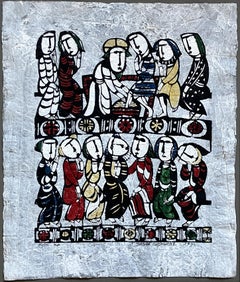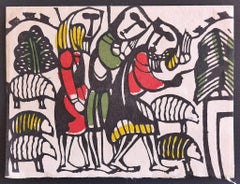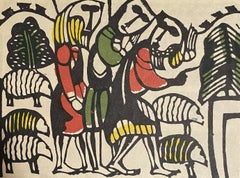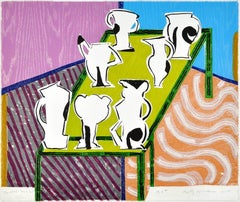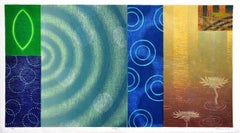Sadao Watanabe. Art
Japanese, 1913-1998
Sadao Watanabe, born in Tokyo in 1913, used the medium called kappazuri ("stencil printing"), a technique related to 'katazome' ("stencil dyeing"). 'Katazome' is said to have originated in Okinawa (the method there was called 'bingata'). The paper most widely used in Japan for stencil printing is called 'shibugami', made from several layers of 'kozo' paper laminated with persimmon tannin. The sheets are dried and smoke-cured to strengthen them and make them flexible and waterproof. Once the artist makes a drawing, it is fixed to the 'shibugami' with a thin adhesive. The basic pattern is then carved into a "key impression" stencil (the equivalent to the keyblock in woodblock printing) called the 'omogata'. If colors will also be used for the final design, separate stencils are sometimes cut for each color. If the stencil pattern has thin lines they can be reinforced with silk gauze, which still allow for uniform printing of colors. The first stage of the printing process involves the application and drying of a dye-resist paste to cover all the portions of the design to be left unprinted by the design. The patterns and colors can then be brushed over the stencil while affecting only those areas without resist paste. Typically the first colors printed are the lighter areas so that darker colors can be overprinted. After all the colors are printed and dried, the key impression stencil is finally used to print the key design over all the previous colors. The dye resist paste is then washed off (called 'mizumoto', "to wash by water") and the paper is dried on a wood board. Watanabe typically printed on a colored ground, so he would first apply a color to the paper.
Watanabe, who was baptized a Christian in 1930, based his designs exclusively on Biblical subjects, though his Christian stories and figures are interpreted through a filter of traditional Japanese techniques and even some older Buddhist figure prints. The folk-art movement in Japan began in the 1930s as an attempt to keep alive various traditional arts, among them stencil printing. Watanabe was an early member of a small but important group of artists who dedicated themselves to learning and preserving these arts. Watanabe's emotioonally moving Biblical prints are have been popular throughout the world, and have been hung in the Vatican, the White House, in museums and in private collections.(Biography provided by Allinson Gallery, Inc.)
to
1
5
2
7
4
2
1
1
1
Christ Washing Feet of Disciples
By Sadao Watanabe
Located in San Francisco, CA
Artist: Sadao Watanabe (1913-1996)
Title: Christ Washing Feet of Disciples
Year: 1970
Medium: Japanese Stencil Dyeing (kappazuri) with hand coloring
Paper: washi paper
Sheet Size: 27.75 x 23.25 inches
Framed size: 34.75 x 30 inches
Edition Size: 50; This one: 42/50
Signature: Brushed signature, date lower right, number lower left.
This fine print is immediately recognizable as the work of Sadao Watanabe (1913-1996) It depicts Christ washing the feet of his disciples. The print and mat are in very good condition. It is floating; attached with three archival hinges to a mounting matboard in gray. It has a white mat. The framing is a simple white metal frame that is in good condition with some light scratches.
Sadao Watanabe was born and raised in Tokyo. Watanabe was famous for his biblical prints rendered in the mingei (folk art) tradition of Japan. As a student of the master textile dye artist Serizawa Keisuke...
Category
1970s Folk Art Sadao Watanabe. Art
Materials
Paper, Stencil
Jonah
By Sadao Watanabe
Located in Santa Monica, CA
SADAO WATANABE (Japanese 1913-1996)
JONAH, 1959
Color stencil, signed, numbered and dated in white ink. Sheet, 25 5/8 x 22 5/8 inches. Edition: 44/50. Good color and generally good ...
Category
1950s Modern Sadao Watanabe. Art
Materials
Stencil, Woodcut
GIRLS WITH LOTS OF QUAILS
By Sadao Watanabe
Located in Santa Monica, CA
SADAO WATANABE (Japanese 1913-1996)
GIRLS WITH LOTS OF QUAILS, 1965
鶉と少女
Hand colored stencil print on momigami textured paper. Signed and numbered in white. Edition 50, Image 17 x 2...
Category
1960s Modern Sadao Watanabe. Art
Materials
Stencil
Shepherds - Woodcut by Sadao Watanabe - Late 20th Century
By Sadao Watanabe
Located in Roma, IT
Shepherds is an original xylography artwork realized by Sadao Watanabe.
The state of preservation is very good.
The artwork is specially designed for the college women' association...
Category
Late 20th Century Contemporary Sadao Watanabe. Art
Materials
Woodcut
Surreal Composit - Woodcut by Sadao Watanabe - 20th Century
By Sadao Watanabe
Located in Roma, IT
Surreal Composit is an original woodcut, hand colored, on paper realized by Sadao Watanabe for College Women's Association of Japan Student Travel grant fund.
Specially woodcut wit...
Category
20th Century Modern Sadao Watanabe. Art
Materials
Woodcut
Moses Smiting the Rock of Meribah, Exodus
By Sadao Watanabe
Located in San Francisco, CA
This artwork, "Moses Smiting the Rock of Meribah, Exodus" 1972 is an original color stencil on hand crumpled momigami paper. It is hand signed, dated and numbered 47/70 in White ink by the artist. The artwork size is 27.5 x 24.75 inches, framed size is 39 x 36 inches. It is custom framed in a wooden gold frame, with matting and black color spacer. It is in excellent condition, Please NOTE, the dark area at the lower left corner of the frame is only the shadow, the frame is in perfect condition.
About the artist:
Sadao Watanabe born and raised in Tokyo, was a Japanese printmaker in the 20th Century. He was famous for his Biblical prints rendered in the mingei (folk art) tradition of Japan. As a student of the master textile dye artist Serizawa Keisuke...
Category
Late 20th Century Modern Sadao Watanabe. Art
Materials
Stencil
Three Men Defending a Fort
By Sadao Watanabe
Located in San Francisco, CA
This artwork, "Three Men Defending a Fort" 1972 is an original color stencil on hand crumpled momigami paper. It is hand signed, dated and numbered 5/20 in black ink by the artist. The artwork size is 26.5 x 22.5 inches, framed size is 36 x 31.75 inches. It is custom framed in a wooden gold frame, with fabric matting and black color spacer. It is in excellent condition.
About the artist:
Sadao Watanabe born and raised in Tokyo, was a Japanese printmaker in the 20th Century. He was famous for his Biblical prints rendered in the mingei (folk art) tradition of Japan. As a student of the master textile dye artist Serizawa Keisuke...
Category
Late 20th Century Modern Sadao Watanabe. Art
Materials
Stencil
Related Items
The White & Black Set
By Betty Woodman
Located in Lyons, CO
Color woodcut/lithograph with chine collé and collage
Woodman returned to Shark's in 2015 to make her most recent print "The White & Black Set". The artist poses a set of white a...
Category
21st Century and Contemporary Contemporary Sadao Watanabe. Art
Materials
Lithograph, Woodcut
Lotus
By Hiroki Morinoue
Located in Lyons, CO
Color woodcut, Edition 30.
Lotus is a twenty-six color woodcut from seven woodblocks printed in an edition of 30, plus proofs, on white Thai Mulberry paper. In this print, a compe...
Category
21st Century and Contemporary Contemporary Sadao Watanabe. Art
Materials
Woodcut
Colorful Russian French Judaica Jewish Shtetl Wedding Lithograph Mourlot Paris
By Mane Katz
Located in Surfside, FL
Mane-Katz (1894-1962) Original Lithograph published by Andre Sauret, Monte Carlo, 1966, printed in France, by Mourlot. The ouvrage sheet is not included. this is from a limited editi...
Category
1960s Modern Sadao Watanabe. Art
Materials
Lithograph
Underwater — Mid-century Modern
By Charles Quest
Located in Myrtle Beach, SC
Charles Quest, 'Underwater', 1948, chiaroscuro wood engraving, edition 12. Signed, titled, dated and numbered '3/12' in pencil. A fine, richly-inked impression, in dark brown and warm black, on off-white wove paper, with full margins (5/8 to 1 1/2 inch), in excellent condition. Scarce.
ABOUT THE ARTIST
Charles Quest, painter, printmaker, and fine art instructor, worked in various mediums, including mosaic, stained glass, mural painting, and sculpture. Quest grew up in St. Louis, his talent evident as a teenager when he began copying the works of masters such as Michelangelo on his bedroom walls. He studied at the Washington University School of Fine Arts, where he later taught from 1944 to 1971. He traveled to Europe after his graduation in 1929 and studied at La Grande Chaumière and Academie Colarossi, Paris, continuing to draw inspiration from the works of the Old Masters.
After returning to St. Louis, Quest received several commissions to paint murals in public buildings, schools, and churches, including one from Joseph Cardinal Ritter, to paint a replica of Velasquez's Crucifixion over the main altar of the Old Cathedral in St. Louis. Quest soon became interested in the woodcut medium, which he learned through his study of J. J. Lankes' A Woodcut Manual (1932) and Paul Landacre's articles in American Artist magazine ‘since no artists in St. Louis were working in wood’ at that time. Quest also revealed that for him, wood cutting and engraving were ‘more enjoyable than any other means of expression.’
In the late 1940s, his graphic works began attracting critical attention—several of his woodcuts won prizes and were acquired by major American and European museums. His wood engraving entitled ‘Lovers’ was included in the American Federation of Art's traveling print exhibition in 1947. Two years later, Quest's two prize-winning prints, ‘Still Life with Grindstone’ and ‘Break Forth into Singing’, were exhibited in major American museums in a traveling show organized by the Philadelphia Print Club. His work was included in the Chicago Art Institute's exhibition, ‘Woodcut Through Six Centuries’, and the print ‘Still Life with Vise’ was purchased by the Museum of Modern Art in New York.
In 1951 he was invited by artist-Curator Jacob Kainen to exhibit thirty wood engravings and color woodcuts in a one-person show at the Smithsonian's National Museum (now known as the American History Museum). Kainen's press release praised the ‘technical refinement’ of Quest's work: ‘He obtains a great variety of textural effects through the use of the graver, and these dense or transparent grays are set off against whites or blacks to achieve sparkling results. His work has the handsome qualities characteristic of the craftsman and designer.’
At the time of the Smithsonian exhibition, Quest's work was represented by three New York galleries in addition to one in his home town. He had won 38 prizes, and his prints were in the collections of the Library of Congress, the Chicago Art Institute, the Metropolitan Museum, and the Philadelphia Museum of Art. In cooperation with the Art in Embassies program, his color woodcuts were displayed at the American Embassy in Paris in 1951.
Recognition at home came in 1955 with his first solo exhibition in St. Louis. Press coverage of the show heralded the ‘growth of graphic arts toward rivaling painting and sculpture as a major independent medium’.
An exhibition of his prints at the Bethesda Art Gallery in 1983 attracted Curator Emeritus Joseph A. Haller, S.J., who began purchasing his work for Georgetown University's collection. In 1990 Georgetown University Library's Special Collections Division was the recipient of a large body of Quest's work, including prints, drawings, paintings, sculpture, stained glass, and his archive of correspondence and professional memorabilia. These extensive holdings, including some 260 of his fine prints, provide a rich opportunity for further study and appreciation of this versatile and not-to-be-forgotten mid-Western American artist...
Category
1940s American Modern Sadao Watanabe. Art
Materials
Woodcut
Jean Cocteau - Young Girl - Original Lithograph
By Jean Cocteau
Located in Collonge Bellerive, Geneve, CH
Jean Cocteau - Young Girl - Original Lithograph
Signed and dated in the plate
Stampsigned
Dimensions: 53 x 42 cm
1956
Provenance : Succession Dermit, Cocteau's heir
Category
1950s Modern Sadao Watanabe. Art
Materials
Lithograph
Happy People : The Parade - Lithograph and Stencil, 1959
By Fernand Léger
Located in Paris, FR
Fernand LÉGER
Happy People : The Parade, 1959
Original lithograph and stencil
Printed signature in the plate
On vellum Auvergne 39,5 x 50 cm (c. 15,3 x 19,6 Inches)
Published in 1959, under the control of the wife of the artist, Nadia Léger...
Category
1950s Modern Sadao Watanabe. Art
Materials
Lithograph, Stencil
Japanese Modernist Sculptor Woodblock (Woodcut) Monotype (Monoprint) Print
By Yasuhide Kobashi
Located in Surfside, FL
Yasuhide Kobashi (古橋 矢須秀 Kobashi Yasuhide, 1931–2003) was a Japanese woodblock print artist, painter, sculptor and stage designer. He was born in Kojima in Okayama Prefecture. His father was a ceramic clay artist and head of the Kyoto Industrial Craft Company. Kobashi learned printmaking from the sōsaku hanga (creative prints) master Unichi Hiratsuka (1895–1997). In 1955, Kobashi graduated from the Kyoto College of Crafts and Textiles, and in 1959, he moved to New York City. At first he was sponsored by Lincoln Kirstein of the New York City Ballet, who had visited his studio in Kyoto and commissioned a number of works from him. Elaine De Kooning, art critic and wife of influential Abstract Expressionist Willem De Kooning recommended Kobashi to the Allan Stone Gallery, He would continue to work with this gallery for more than 30 years.
When Kobashi moved to New York in 1959, many American intellectuals and artists were eager to learn about Japan. Among the early influences to reach a wide cross section of American society was Suzuki Daisetsu's (1870-1966) Introduction to Zen Buddhism, published in English in 1949 with a preface by the noted psychologist Carl Jung.
Nelson Rockefeller (governor of New York and later vice-president) was Kobashi's patron, and acquired one of the artist's sculptures for the New York State Executive Mansion in Albany. As a young man he was exposed to a wide range of arts, including sculpture, stage design, carpentry, stone cutting, ceramics, calligraphy, painting, and furniture design. Most notably, he studied woodblock printmaking under Hiratsuka Unichi (1895-1997), one of the leading innovators in the Creative Print (ssaku-hanga) movement that advocated total artistic control by a single artist over the entire printmaking process, in contrast to the traditional methods of ukiyo-e in which designer, carver, printer, and publisher all had a role in production.
Kobashi is best known for his sosaku hanga woodblock prints and his sculptures intended to be rearranged, which he called "self-constructions". The Cleveland Museum of Art, the Honolulu Museum of Art, the Metropolitan Museum of Art, the Museum of Modern Art (MoMA New York City), the Neuberger Museum of Art (Purchase, New York), the Albright Knox, the Weisman Art Museum (University of Minnesota, Minneapolis), and Southern Illinois University Edwardsville are among the public collections holding work by Kobashi.
Yasuhide Kobashi created some of his first prints in New York at the Pratt Graphic Art Center. He became a member of the Society of Independent Artists and exhibited regularly with them.
He is included in the book JAPANESE SCULPTORS: Isamu Noguchi, Yayoi Kusama, Akio Takamori, Yoshimoto Nara...
Category
20th Century Modern Sadao Watanabe. Art
Materials
Monoprint, Monotype, Woodcut
Judaica Jewish Shtetl Wedding Klezmer Musician Lithograph Mourlot Paris
By Mane Katz
Located in Surfside, FL
Mane-Katz (1894-1962) Original Lithograph published by Andre Sauret, Monte Carlo, 1966, printed in France, by Mourlot. The ouvrage sheet is not included. this is from a limited editi...
Category
1960s Modern Sadao Watanabe. Art
Materials
Lithograph
Colorful Russian French Judaica Jewish Shtetl Wedding Lithograph Mourlot Paris
By Mane Katz
Located in Surfside, FL
Mane-Katz (1894-1962) Original Lithograph published by Andre Sauret, Monte Carlo, 1966, printed in France, by Mourlot. The ouvrage sheet is not included. this is from a limited editi...
Category
1960s Modern Sadao Watanabe. Art
Materials
Lithograph
Large French Judaica Lithograph Colorful Jewish Jerusalem Hebrew
By Théo Tobiasse
Located in Surfside, FL
Theo Tobiasse
Title "Jerusalem de tous les fruiets"
Medium: Original lithograph in colors on paper (deckle edged paper)
Hand signed and numbered in pencil by the artist
Paper size : 36x27 in (92x69 cm)
Image size : 30x22 in (77x55 cm)
Edition : 199
Year : 1999
This depicts a Dove of peace over a basket of first fruits in the Old City of Jerusalem
Theo Tobiasse, (Israeli-French) born Tobias Eidesas, 1927 in Jaffa, Israel then in British Mandate Palestine, died 2012 in Cagnes-sur-Mer in France. Well known painter, engraver, draftsman and sculptor. French Jewish artist.
The youngest son of Chaim (Charles) Eidesas and Brocha (Berthe) Slonimsky from Kaunas, Lithuania, Théo Tobiasse was born in Mandatory Palestine in 1927, where his Jewish parents lived since 1925, far from the threat of pogroms and upheavals of East European policies. The family encountered material difficulties and decided to return to Lithuania, ultimately leaving for Paris in 1931 where his father typographer finds work in a Russian printing press.
Theo Tobiasse shows very early talent for drawing and painting, and during a visit to the Special Exhibition of 1937 held in Paris, he is enchanted by Raoul Dufy.
The death of his mother (in June 1939) followed by the outbreak of the Second World War, Paris under the German Nazi occupation, the wearing of the yellow star and his registration at the National School of Decorative Arts denied for racist reasons upsets his life. He enrolled in a private advertising design course on the boulevard Saint-Michel, which he abandoned nine months later because his family, narrowly escaping the Winter Vélodrome roundup in July 1942 was forced to hide in an apartment in Paris for two years. At the Liberation of Paris, he quickly began a career as an advertising graphic designer with the Draeger art printer and also produced tapestry cartoons, stage sets and Hermes showcases at the Hermès boutique on rue du Faubourg Saint-Honoré.
In 1950, he obtained French nationality and moved to Nice in the Alpes-Maritimes, where he continued his advertising graphic design career.
His first paintings were exhibited at the Salon des peintres du Sud-Est in 1960. He was laureate in 1961 the "prize of the young Mediterranean painting" and Armand Drouant offers him a first contract and exhibited at the Faubourg Saint-Honoré Gallery in Paris in 1962.
Théo Tobiasse also won the Dorothy Gould Prize in 1961. He decided to devote himself solely to the visual arts. Numerous exhibitions are dedicated to him all over the world, in Paris at the Drouant Gallery, in Geneva, Montreal or Tokyo, then London, Zurich, Lausanne, Los Angeles, Kiev, and then a first personal exhibition in New York (1968). Self-taught, he studied the technique of grand masters in museums during his travels. The reliefs, glazes and colors of Rembrandt's Jewish Fiancee at the Rijksmuseum in Amsterdam, in particular, open up new technical possibilities that he explores in his canvases back to his studio.
The figurative subjects without narrative or symbolism (cat, bird, kite, velocipede, etc.) of his first paintings, allow him to focus on the techniques, the color and the texture of oil painting and gouache.
From 1964, Theo Tobiasse develops a more personal iconography drawn from his own memories of his childhood in Lithuania, the wanderings of a family seeking a land of asylum and the Holocaust. The train, the one which drove his family from Kaunas to Paris, or the Jews to the camps, becomes a recurring motif and memory a major theme in his work.
A visit to Jerusalem, Israel in 1970 brings him closer to his Israeli Jewish origins. He created his first Judaic stained-glass windows on the theme of "Jewish Feasts" for the Jewish Community Center in Nice and a monumental oil painting titled " Que tentes sont beau", O Jacob (1982). He continues to travel and immerse himself in the cultures he meets, New Orleans jazz, Mexican archaeological sites and Native American totems . In New York, he meets Elie Wiesel (1982). While Josy Eisenberg makes a film about Théo Tobiasse, entitled Tell me who you are painting, for French television in 1977, many personal exhibitions are devoted to him in France and abroad, notably at the Passali gallery in Paris, France. Atheneum Museum in Geneva and the Nahan Gallery in New Orleans. In 1983, a retrospective exhibition of his work was organized in Nice , at the Museum of Contemporary Art in Ponchettes.
Carborundum engraving, lithography, stained glass, mosaic, pottery, bronze and ceramic sculpture are all tools of expression he first explored in the studio he had built at his home on the heights of Nice (1954 -1972), then to the Rauba Capeu wharf in Nice (1971-1976).
He leaves Nice to install his main workshop on his property in Saint-Paul-de-Vence in 1976.
In collaboration with Pierre Chave, lithographer in Saint-Paul-de-Vence, Théo Tobiasse is developing a technique for making lithographs of eighteen to twenty colors that he produces for many original portfolio editions published in France, Sweden and the United States.
In addition to the theme of memory of the wanderings and exodus of his family and the Jewish people, the personal iconography of Tobiasse comprises three other major themes that recur in his work: The cities that are dear to him (Paris and Jerusalem, first, then New York and Venice from the 1980s); twenty-eight monochrome gouaches, From Notre-Dame to Saint-Germain-des-Près (1969).
The Hebrew Bible, an endless source of human dramas, which he re-imagines in contemporary times. Rachel (1978), Sarah and the three messengers (1981),Bathsheba in the Garden of Pomegranates (1982).
The woman, lover, erotic and shameless, Daphnis and Chloé (1978), Portrait of a woman immobile in ecstasy , (1978), a creature-sex apple whose skin burns and arms twist (1980).
To explore the theme of the erotic woman, Tobiasse adopts nude drawing in graphite, ink and pastel on paper, as well as the writing of poetic texts he inscribed in his drawings and notebooks.
The American merchant, Kenneth Nahan Sr., met in 1978, encourages Théo Tobiasse to join in the United States other French painters he represents, including Max Papart and James Coignard. Tobiasse moved to New York in 1984. He first worked at the Chelsea Hotel and then set up his studio in Manhattan. He decides to split his time and his work between Saint-Paul-de-Vence and New York.
The first paintings painted in America are distinguished from their European production by their scale and their bright themes. Oil-painted canvases are filled with family portraits, children, and biblical characters. My family came from Lithuania, Little Girl Sitting , Saul and David (1984). In these paintings, families no longer flee the pogroms in the trains, but land in New York, new host country according to his imagination, as in America (1984). He also created the Myriam sculpture in New York, which became the model for the Venus, a monumental bronze sculpture to be installed at the entrance of Saint-Paul-de-Vence in 2007 15. New York joins the inspiring cities of Theo Tobiasse and the woman now personifies freedom. Along with Marc Chagall, Raya Sorkine, Zamy Steynovitz and Yoel Benharrouche, Tobiasse becomes one of the pillars of modern French Judaica art.
Back in Saint-Paul-de-Vence, he experimented new techniques from 1986. He abandoned oil painting and gouache for acrylic, less restrictive. His mixed techniques on paper or canvas, mix collage, acrylic painting and pastels. He develops cut and painted wood or steel panels for large formats and public display.
In 1992, a retrospective exhibition of Théo Tobiasse's work was organized at the Cagnes-sur-Mer castle-museum. His workshops become meeting places for artist friends such as Ben and Arman. Chaim Potok visits Saint Paul's studio several times, dedicates to him a Tobiasse monograph: Artist in Exile published in 1986 in New York, and there meets the writer James Baldwin, friend and neighbor of Théo Tobiasse in 1987.
He travels extensively for his solo shows. In 1987, Vision New Japan exhibited his latest paintings in Tokyo , Kokura and Mito and then in 1991, large sculptures in carved and painted wood panels in Tokyo , Osaka , Nagoya , Kobe , Fuokoka and Taipei . He discovers Prague in 1992 and returns there in 1995, and travels every year to Venice to draw.
Théo Tobiasse discovers the work of set design with the creation of sets and costumes for the puppet theater. He creates an album of lithographs for the fifth centenary of the expulsion of the Jews from Spain. The Garden of the Psalms , a series of seven stained glass windows created in the workshop of the master glassmaker Alain Peinado, is inaugurated at the Esplanade Jewish community center in Strasbourg on the occasion of the bicentennial of the emancipation of the Jews. He continues with the creation of twelve monumental windows entitled The Song of the Prophets for the Nice Synagogue which are inaugurated in 1993.
In 1994, he participated with other artists of the Nice region (Arman, Ben, Jean-Claude Farhi, Claude Gilli...
Category
1990s Modern Sadao Watanabe. Art
Materials
Lithograph
Post Soviet Nonconformist Avant Garde Russian Israeli Woodcut Woodblock Print
By Michail Grobman
Located in Surfside, FL
Woodcut woodblock (small possibility it is a Silkscreen Serigraph) print hand signed, numbered.
Michail Grobman (Russian: Михаил Гробман, Hebrew: מיכאיל גרובמן, born 1939) is an a...
Category
20th Century Modern Sadao Watanabe. Art
Materials
Woodcut
Untitled
By Charles William Smith
Located in Fairlawn, OH
Untitled
Color woodcut, 1939
Unsigned as issued
Signed and dedicated by the artist on the justification page (see photo)
From:
Abstractions By Charles Smith
Forward by Carl O. Schnie...
Category
1930s American Modern Sadao Watanabe. Art
Materials
Woodcut
Sadao Watanabe. art for sale on 1stDibs.
Find a wide variety of authentic Sadao Watanabe. art available for sale on 1stDibs. If you’re browsing the collection of art to introduce a pop of color in a neutral corner of your living room or bedroom, you can find work that includes elements of blue and other colors. You can also browse by medium to find art by Sadao Watanabe. in stencil, woodcut print, paper and more. Much of the original work by this artist or collective was created during the 20th century and is mostly associated with the modern style. Not every interior allows for large Sadao Watanabe. art, so small editions measuring 8 inches across are available. Customers who are interested in this artist might also find the work of Kiyoshi Saitō, Mikio Watanabe, and Utagawa Kunisada III. Sadao Watanabe. art prices can differ depending upon medium, time period and other attributes. On 1stDibs, the price for these items starts at $501 and tops out at $2,550, while the average work can sell for $2,000.
